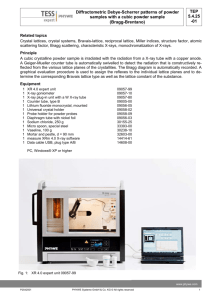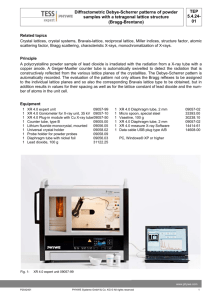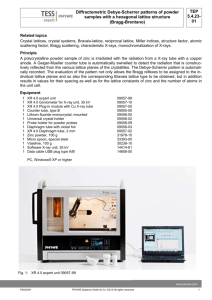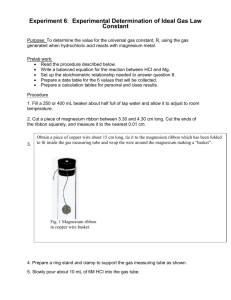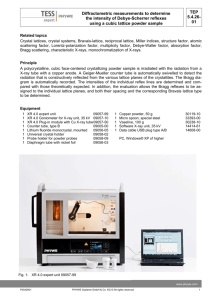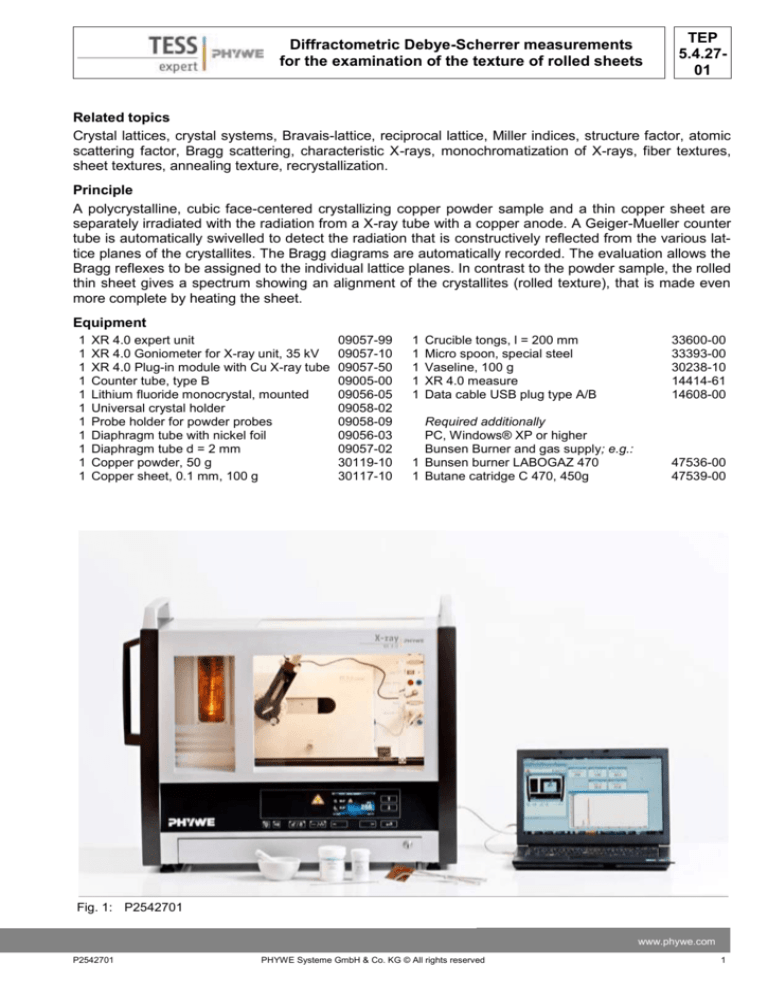
Diffractometric Debye-Scherrer measurements
for the examination of the texture of rolled sheets
TEP
5.4.2701
Related topics
Crystal lattices, crystal systems, Bravais-lattice, reciprocal lattice, Miller indices, structure factor, atomic
scattering factor, Bragg scattering, characteristic X-rays, monochromatization of X-rays, fiber textures,
sheet textures, annealing texture, recrystallization.
Principle
A polycrystalline, cubic face-centered crystallizing copper powder sample and a thin copper sheet are
separately irradiated with the radiation from a X-ray tube with a copper anode. A Geiger-Mueller counter
tube is automatically swivelled to detect the radiation that is constructively reflected from the various lattice planes of the crystallites. The Bragg diagrams are automatically recorded. The evaluation allows the
Bragg reflexes to be assigned to the individual lattice planes. In contrast to the powder sample, the rolled
thin sheet gives a spectrum showing an alignment of the crystallites (rolled texture), that is made even
more complete by heating the sheet.
Equipment
1
1
1
1
1
1
1
1
1
1
1
XR 4.0 expert unit
XR 4.0 Goniometer for X-ray unit, 35 kV
XR 4.0 Plug-in module with Cu X-ray tube
Counter tube, type B
Lithium fluoride monocrystal, mounted
Universal crystal holder
Probe holder for powder probes
Diaphragm tube with nickel foil
Diaphragm tube d = 2 mm
Copper powder, 50 g
Copper sheet, 0.1 mm, 100 g
09057-99
09057-10
09057-50
09005-00
09056-05
09058-02
09058-09
09056-03
09057-02
30119-10
30117-10
1
1
1
1
1
Crucible tongs, l = 200 mm
Micro spoon, special steel
Vaseline, 100 g
XR 4.0 measure
Data cable USB plug type A/B
Required additionally
PC, Windows® XP or higher
Bunsen Burner and gas supply; e.g.:
1 Bunsen burner LABOGAZ 470
1 Butane catridge C 470, 450g
33600-00
33393-00
30238-10
14414-61
14608-00
47536-00
47539-00
Fig. 1: P2542701
www.phywe.com
P2542701
PHYWE Systeme GmbH & Co. KG © All rights reserved
1
TEP
5.4.2701
Diffractometric Debye-Scherrer measurements
for the examination of the texture of rolled sheets
Tasks
1. Record the intensity of the Cu X-rays back scattered by a cubic crystallizing copper powder sample
as a function of the scattering angle.
2. Assign the Bragg reflexes to the individual lattice planes.
3. Record the Bragg spectrum of a thin sheet of copper.
4. Repeat the measurements made in Task 3 after the sheet of
copper has been subjected to annealing.
Set-up
Connect the goniometer and the Geiger-Müller counter tube to
their respective sockets in the experiment chamber (see the red
markings in Fig. 2). The goniometer block with the analyser crystal should be located at the end position on the left-hand side.
Fasten the Geiger-Müller counter tube with its holder to the back
stop of the guide rails. Do not forget to install the diaphragm in
front of the counter tube.
Insert a diaphragm tube with a diameter of 2 mm into the beam
outlet of the tube plug-in unit.
Note
Details concerning the operation of the X-ray unit and goniome- Fig. 2: Connectors in the experiment
ter as well as information on how to handle the monocrystals
chamber
can be found in the respective operating instructions.
Holder for Powder
samples and universal crystal holder
Counter
tube diaphragm
GM-counter
tube
diaphragm tube
d = 2 mm
Goniometer at the
left end position
Fig. 3: Set-up of the goniometer
2
PHYWE Systeme GmbH & Co. KG © All rights reserved
P2542701
Diffractometric Debye-Scherrer measurements
for the examination of the texture of rolled sheets
TEP
5.4.2701
Procedure
- Connect the X-ray unit via the USB cable to the
USB port of your computer (the correct port of
the X-ray unit is marked in Figure 4).
- Start the “measure” program. A virtual X-ray unit
will be displayed on the screen.
- You can control the X-ray unit by clicking the
various features on and under the virtual X-ray
Fig. 4: Connection of the computer
unit. Alternatively, you can also change the parameters at the real X-ray unit. The program will
automatically adopt the settings.
- Click the experiment chamber (see the red
marking in Figure 5) to change the parameters
for the experiment. Select the parameters as
shown in the text box.
- If you click the X-ray tube (see the red marking
in Figure 5), you can change the voltage and
current of the X-ray tube. Select the parameters
as shown in the text box: Anode voltage UA = 35
kV; anode current IA = 1 mA..
- Start the measurement by clicking the red circle:
-
For setting the
X-ray tube
After the measurement, the following window
appears:
For setting the
goniometer
Fig. 5: Part of the user interface of the software
-
-
Select the first item and confirm by clicking
OK. The measured values will now be transferred directly to the “measure” software.
At the end of this manual, you will find a brief
introduction to the evaluation of the resulting
spectra.
Note
- Never expose the Geiger-Müller counter tube
to the primary X-radiation for an extended period of time.
Overview of the settings of the goniometer and
X-ray unit:
- 1:2 coupling mode
- angle step width 0.1°
- Scanning range 10°-45°
- Anode voltage UA = 35 kV; anode current
IA = 1 mA
- Scanning speed: when only very intense reflex lines are to be recorded, then scanning
can be relatively rapid at 10 s/°. For the
identification of weaker lines, a scanning
speed of at least 30 s/° is required for a better signal-noise ratio. The experiment with
the sheet of copper can be carried out using
a scanning speed of 20 s/°. In addition, for a
more exact evaluation, it is recommended
that the position of the glancing angle be determined to two decimal places and that the
zoom function be used for the region where
lines are close together.
www.phywe.com
P2542701
PHYWE Systeme GmbH & Co. KG © All rights reserved
3
TEP
5.4.2701
Diffractometric Debye-Scherrer measurements
for the examination of the texture of rolled sheets
Preparation of the copper powder sample
A relatively high sample concentration is obtained when the powder is mixed with a little vaseline. To do
this, transfer a little of the copper powder onto a sheet of paper and use a spatula to knead it to a firm
paste. To achieve the highest concentration of material as possible, use very little vaseline (a spatula tip
of it). Fill the relatively solid paste into the specimen for powder samples and smooth it flush. Use the
universal crystal holder to hold the specimen.
Preparation of the copper sheet sample
For better handling, use scissors to cut the copper sheet to a size of (2.5 x 4) cm. The surface of this
sample sheet that is to be examined must be completely free of oxide and brightly polished. To achieve
this, first use very fine emery paper (1,000 grain) to carefully remove any oxide, then use polishing paste
to brightly polish the surface. Clamp a strip of paper under the sample to firmly fix it in the universal crystal holder. After having carried out the experiment with the brightly polished sample, initiate recrystallization of the sample as follows: Heat the sample carefully to a bright redness (approx. 700°C) for about 2-3
seconds with a Bunsen burner flame, then allow the sheet to cool slowly in air. Again carry out the subsequent measurement on the bright sample surface.
Calibration of the goniometer with the LiF single-crystal:
Exact angular positions of Debye-Scherrer reflections are only to be expected when the goniometer is
correctly adjusted. Should the goniometer be out of adjustment for any reason whatever, this can be
overcome by stepwise carrying out of the following procedure: In the coupled 2:1 mode, set the LiF single-crystal at an angle of ϑ= 22.5°. Theoretically, the very intense 200 reflection from LiF lies at this angle. Now, search for the maximum intensity of the reflection by turning the crystal and counter tube separately and alternately through a few 0.1° angular steps. Should the maximum be found at 22.3°, for example, i.e. 0.2° below the theoretical value, then couple the crystal and counter tube together again and
turn the crystal through -0.2° past the zero position. Save this corrected zero position by selecting
“menu”, “goniometer” and “set to zero”. The maximum intensity must now be situated exactly at the angle of 22.5°. Carry out a corresponding positive zero position correction should the maximum be found at
an angle greater than 22.5°.
Theory and Evaluation
When X-rays of wavelength λ strike a mass of lattice planes of a crystal of spacing d at a glancing angle
of ϑ, then the reflected rays will only be subject to constructive interference when Bragg’s condition is fulfilled, i.e.:
2d sin n (n = 1, 2, 3, ...)
(1)
Copper crystallizes in a cubic face-centered lattice, the unit cell of which has 4 atoms at the coordinates
000, ½ ½ 0, ½ 0 ½ and 0 ½ ½. For a face-centered lattice consisting only of one sort of atom, the structure factor, which determines which lattice planes contribute to constructive interference of the partial
waves scattered at the individual lattice elements, the following is valid:
|F|2 = 16 f 2 with h k l only even or only odd
|F|2 = 0
with h k l mixed
(2)
where h, k, l = Miller indices of the reflecting lattice planes. The atomic scattering factor f describes the
scattering power of an individual atom and is defined as the scattering amplitude of an atom divided by
the scattering amplitude of a free electron.
4
PHYWE Systeme GmbH & Co. KG © All rights reserved
P2542701
Diffractometric Debye-Scherrer measurements
for the examination of the texture of rolled sheets
TEP
5.4.2701
For the cubic crystal system, the spacings d of the individual lattice planes with the indices (h k l) are obtained from the quadratic form:
1
1
2 h 2 k 2 l 2 (a = Gitterkonstante)
2
d hkl a
(3)
From this and equation (1), the quadratic Bragg equation is obtained for n = 1:
sin 2
2
4a 2
h
2
k2 l2
(4)
Task 1
Fig. 2 shows the Debye-Scherrer spectrum of the
copper powder sample (Cu, Z = 29).
As no filter is used for the monochromatization of
the X-rays, the fact that the very intense lines resulting from Kα- radiation are accompanied by secondary lines resulting from the weaker Kβ radiation
must be taken into consideration when individual
lines are evaluated.
Such pairs of lines can be identified by means of
equation (1). It is namely approximately true with
λ(Kα) = 154.18 pm and λ(Kβ) = 139.22 pm that:
K sin 154,18 pm
1,1
K sin 139,22 pm
(5)
This value corresponds with the quotients of the
sinϑ values (Fig. 2) of the pairs of lines 2-1, 4-3, 65, 9-7 and 10-8, showing that the lines 1, 3, 5, 7
and 8 originate from the Cu Kb radiation.
The correctness of this conclusion can be shown by
a control measurement using the diaphragm tube
with nickel foil to reduce the intensity of the Kβ radi- Fig. 2: Debye-Scherrer diagram of a copper powder
probe
ation. The reflexes in Fig. 3 that were previously
assigned to the Kβ lines are no longer to be seen.
As the intensity of the Kα- radiation is also somewhat weakened by the Ni foil, when this is used the detection of reflexes of weak intensity at larger glancing angles is made difficult.
Task 2:
The Table shows the evaluation of the spectrum shown in Fig. 2.
Column D of the Table lists the glancing angles ϑ found in the experiment alongside the individual reflex
lines to which they belong. As it has already been assumed that copper forms a face-centered lattice,
only the permissible hkl triplets for this type of lattice have been taken into consideration in column B.
Column G lists the lattice plane spacings d calculated using equation (1), and column H contains the
values of the lattice constant a calculated using equation (3).
www.phywe.com
P2542701
PHYWE Systeme GmbH & Co. KG © All rights reserved
5
TEP
5.4.2701
Diffractometric Debye-Scherrer measurements
for the examination of the texture of rolled sheets
Table 1: Evaluation of the Kα - and Kβ Debye-Scherrer lines of Cu.
A
Line
1(β)
2
3(β)
4
5(β)
6
7(β)
8(β)
9
10
B
hkl
C
h2+k2+l2
D
ϑ/°
111
111
200
200
220
220
311
222
311
222
3
3
4
4
8
8
11
12
11
12
19,54
21,73
22,75
25,29
33,00
37,11
39,69
41,85
45,08
47,65
E
F
sinϑ
0,334464
0,370233
0,386711
0,427000
0,544639
0,603347
0,638633
0,667183
0,708093
0,739043
sin2ϑ
0,111867
0,137073
0,149545
0,182500
0,296632
0,364203
0,407853
0,445133
0,501396
0,546185
G
d/pm
H
a/pm
208,12
208,22
180,00
180,45
127,81
127,77
109,00
105,33
108,87
104,31
360,48
360,65
360,00
360,91
361,50
361,39
361,61
361,42
361,08
361,34
The mean value of a obtained is: a = (361.04 ±
0.52) pm; Δa/a = ± 0.15%.
(Literature value: a = 361.52 pm).
The intensities of the individual reflex lines correspond with those theoretically expected. With powder samples, the 111 reflex should have the greatest intensity, and the 200 reflex the next highest intensity. The 220 reflex has a lower intensity.
Task 3:
When the same experiment is carried out on the
copper sheet sample, and this sample aligned to the
direction of the primary radiation, so that this impinges on the sample parallel to the rolling direction
(small recognizable striations run vertically to the
rolling direction), then it is found that the intensity relationships of the individual reflex lines are almost
reversed (see Fig. 3). The 220 reflex now has the
greatest intensity, followed by the 200 and the 111
reflexes. The intensity of the 311 reflex remains
about the same with both samples. These results
remain unchanged when the flat copper sheet sample is moved round through 90°, so that the primary Fig. 3: Debye-Scherrer diagram of a rolled copper
sheet
radiation is vertical to the rolling direction.
The rolling process has done away with the previous random distribution of the individual crystallites.
These are now partially unidirectional (rolling texture). It is shown here that for the most part the crystallites are so directed that both the 100 cube faces
as well as the 110 planes lie preferentially parallel to
the rolling direction (see Fig. 4). Whether a further
crystallographic direction lies additionally parallel to
the rolling direction, e.g. whether a 110 direction (i.e.
a cube face diagonal) is directed parallel, cannot be
decided here. The formation and type of the texture
of sheet metal is very dependent on the degree of
rolling, among other factors.
Fig. 4: Alignment of the Cu-grains in the plane of the
sheet (rolling plane): a.) not annealed Cu-sheet; b.) after
annealing
6
PHYWE Systeme GmbH & Co. KG © All rights reserved
P2542701
Diffractometric Debye-Scherrer measurements
for the examination of the texture of rolled sheets
TEP
5.4.2701
Task 4:
When the copper sheet is now briefly heated to
redness, the subsequent analysis shows that the
relationships have changed even more drastically
(see fig. 5). The crystallites are now almost completely aligned as, apart from the weak remains of
a 111 reflex signal (line 2), only the 200 reflex has
a very strong intensity. Annealing has resulted in
recrystallization, which has resulted in the crystallites being almost completely aligned with their 100
cube faces parallel to the rolling plane (see Fig.
4b).
Fig. 5: Debye-Scherrer pattern of a rolled copper sheet
after annealing
www.phywe.com
P2542701
PHYWE Systeme GmbH & Co. KG © All rights reserved
7
TEP
5.4.2701
8
Diffractometric Debye-Scherrer measurements
for the examination of the texture of rolled sheets
PHYWE Systeme GmbH & Co. KG © All rights reserved
P2542701


